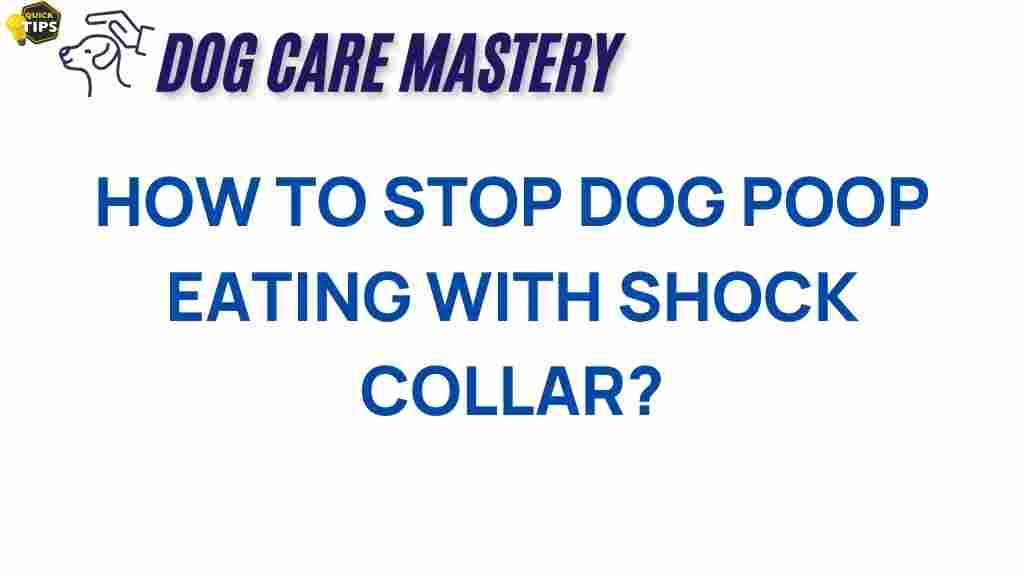The Controversial Use of Shock Collars: Can They Stop Dogs from Eating Poop?
Dog behavior can often be perplexing and frustrating for pet owners. One particularly troublesome habit that some dogs develop is coprophagia, or the act of eating feces. This behavior can lead owners to seek out various solutions, including the controversial use of shock collars. In this article, we will explore the implications of using shock collars on dogs, particularly in the context of stopping them from engaging in this unwanted behavior.
Understanding Dog Behavior and Coprophagia
Before diving into the methods of controlling this behavior, it’s essential to understand why dogs may engage in coprophagia. Several factors can contribute to this habit:
- Instinctual Behavior: Some dogs may eat feces as a natural instinct, inherited from their ancestors who would keep their dens clean.
- Nutritional Deficiency: Dogs may eat feces if they are lacking certain nutrients in their diet.
- Attention-Seeking: Dogs may engage in this behavior if they notice it elicits a strong reaction from their owners.
- Stress or Anxiety: Stressful environments can lead to unusual behaviors, including coprophagia.
Understanding these underlying causes can help pet owners make informed decisions about how to address the issue. While some may consider shock collars a solution, it’s crucial to evaluate their effectiveness and the potential consequences on dog behavior.
What Are Shock Collars?
Shock collars, also known as electronic collars, are devices designed to deliver a small electric shock to a dog as a form of correction. These collars are often used in training to discourage unwanted behaviors. Here’s how they typically work:
- The collar is equipped with a remote control that allows the owner to administer a shock when the dog displays undesirable behavior.
- Shock intensity can usually be adjusted according to the severity of the behavior.
- Some collars also feature sound or vibration modes as alternatives to the shock.
While proponents argue that shock collars can effectively modify behavior, many experts in dog behavior caution against their use, especially for issues like coprophagia.
The Pros and Cons of Using Shock Collars
When it comes to addressing dog behavior, especially concerning coprophagia, it’s essential to weigh the pros and cons of shock collars.
Pros:
- Immediate Feedback: Shock collars provide instant feedback, which can help some dogs associate their actions with negative consequences.
- Control Over Behavior: For dogs that are unresponsive to other training methods, shock collars can sometimes yield quick results.
Cons:
- Negative Associations: Dogs may develop a fear of their owners or the environment if they associate it with the shock.
- Potential for Abuse: Without proper training and guidance, some owners may misuse shock collars, leading to physical and emotional harm.
- Lack of Understanding: Shock collars do not address the root causes of coprophagia, which may lead to a recurrence of the behavior.
The potential for harm and the ethical concerns surrounding the use of shock collars lead many trainers and behaviorists to advocate for more humane training methods.
Humane Alternatives to Shock Collars
Instead of resorting to shock collars, consider these humane alternatives to modify your dog’s behavior:
- Positive Reinforcement: Reward your dog for desired behaviors with treats or praise instead of punishing them for unwanted actions.
- Training Classes: Enroll your dog in training classes to learn effective commands and behaviors in a controlled environment.
- Dietary Adjustments: Consult with a veterinarian to ensure your dog is receiving a balanced diet that meets their nutritional needs.
- Environmental Management: Keep your yard clean and supervise your dog during walks to prevent access to feces.
Implementing these strategies can effectively reduce instances of coprophagia without causing distress to your dog.
Step-by-Step Process to Address Coprophagia
Here’s a practical step-by-step approach to help stop your dog from eating poop:
- Identify Triggers: Observe your dog to determine when and where they are most likely to engage in coprophagia.
- Modify Diet: Consult your veterinarian about your dog’s diet and make necessary adjustments to ensure nutritional adequacy.
- Increase Supervision: Keep your dog on a leash during walks and closely monitor playtime in the yard to prevent access to feces.
- Use Commands: Teach commands like “leave it” or “no” to discourage your dog from approaching feces.
- Positive Reinforcement: Reward your dog with treats and praise when they ignore feces and focus on you instead.
By following these steps, you can effectively change your dog’s behavior and reduce the likelihood of coprophagia.
Troubleshooting Tips
If you find that your dog’s behavior persists despite your efforts, consider these troubleshooting tips:
- Consult a Professional Trainer: Sometimes, the assistance of a professional dog trainer can provide new insights and techniques for addressing the behavior.
- Evaluate Stress Levels: Assess any changes in your dog’s environment that could be contributing to stress or anxiety.
- Keep a Consistent Routine: Dogs thrive on routine; maintaining a consistent feeding and walking schedule can help alleviate anxiety.
Recognizing that each dog is unique and may respond differently to training methods is crucial. Be patient and persistent in your approach.
Conclusion
The use of shock collars in addressing dog behavior, particularly coprophagia, remains a controversial topic. While some may find success with these devices, the potential for negative consequences often outweighs the benefits. Instead, focusing on humane training methods, understanding the underlying causes of the behavior, and implementing positive reinforcement can lead to long-lasting changes in your dog’s habits.
Ultimately, the goal should be to foster a trusting and positive relationship with your dog, paving the way for a happier and healthier life together. For more information on dog behavior and training, you can visit this resource.
For comprehensive insights on various dog behaviors, check out this expert article.
This article is in the category Behavior and created by dogcaremastery Team
